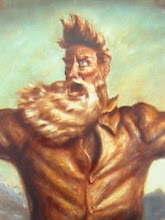This is a view of the best seat outside of the house:
The tiller box. The source of many smiles and much sweat. If you have never had the opportunity to tiller, I highly recommend it. It takes some training and a lot of practice to stay proficient, but it is a blast.
For those of you who are not in the fire service, the tiller steers the wheels at the back of the trailer. The tillerman does this from a box mounted on the rear of the trailer. The tiller box contains a seat, a steering wheel and a buzzer pedal. The tillerman communicates with the driver through a headset and intercom. Not much else is needed.
photo courtesy of San Jose Fire dept.
The purpose of the tiller is to allow a very large truck to have the ability to turn around and maneuver in area much smaller than vehicles not so equipped. When we fist started receiving tiller equipped ladder trucks, I was amazed at their immense size. I really thought that they would be impeded by their size and that we would soon be buying more "light" trucks, which are built on a smaller chassis.
After a few training sessions, it became that the tiller equipped ladder trucks could out turn the light trucks as well as the much shorter engines. We continue to buy tiller- trucks to this day.
I am not going to go into how to tiller a truck, but it does take quite a bit of training. More than a few dents and scratches have been put on ladder trucks by improperly trained tillermen.
As with any coordinated operation, communication and cooperation is the key to success. The driver and the tillerman need to communicate continuously about conditions, intentions, hazards and other matters. The driver needs to remember that the tillerman is back there and be proactive in order to reduce his workload. The tillerman needs to communicate his situation and needs to the driver.
When coordination fails, events like this might be the result:
Photo kyped off of the internet
I don't know anything about this accident, other than it must have been a traumatic event to all involved. We have been fortunate at the K.B.F.P.D, most of our mishaps have been minor.
Although I was never assigned to a ladder truck as a tillerman, I spent a lot of years on a truck as a captain. As a result, I was trained to tiller and did so often. I enjoyed the challenge and it was just plain fun.
The truck from our district stopped by the other day to drop off some equipment and I climbed up into the box just to see if it had changed at all. I am happy to say, it had not. Although I prefer engine work over most truck work, I still kind of miss the box.
Not enough to transfer back into the Big House of Pain though.
Thanks for reading,
Schmoe






Dear Captain,
ReplyDeleteI have always wanted to know about that "wheelbox seat" which I now know is called a "tiller."
Thank you!
Ann T.
I agree, it sure is fun. Icy roads in our Minnesota winters add a bit of challenge.
ReplyDeleteYou get some funny looks from people in cars next to you when the suddenly realize there is someone up there in the tiller. You also see some interesting things going on in cars next to you when they don't.
I remember seeing these as a kid. I don't remember them having nice glass houses for the tillerman. One of my childhood memories is of a big red fire truck going by with the tillerman there on the end, exposed to the slipstream and weather. I didn't know then what he was doing there, but it seemed to my young eyes like the coolest place to be on the whole truck.
ReplyDeleteSay, Captain, what's the buzzer pedal for?
Ann T - Maybe the term tiller is a holdover from the nautical world?
ReplyDeleteAnon - I can't imagine tillering on ice. Are the rear tires chained?
Wayne - The buzzer pedal is a small foot operated pedal on the floor of the tiller box. When depressed, it sounds a buzzer located in the cab. If the intercom goes down, the tillerman can communicate using the buzzer pedal. 1 buzz = stop; 2 buzzes = go; 3 buzzes = back up.
I also forgot to mention the dead-man switch. It is another foot operated pedal that must be depressed or the rig will not start. This prevents the truck from starting and taking off without a tillerman. It does not, however, prevent the rig from moving without a tillerman once it is started.
Thanks all for commenting
Good post. I remember seeing the helmsman out in the open, without a windshield or anything. Clearly it was a far better position than the fellow driving. The other coveted position(s) were the firemen hanging on to the rear of the truck, riding along on a platform of sorts.
ReplyDeleteWe have one tiller truck in our fire department.
I was honored with the opportunity to get a bit of driver's training both tiller and tractor while visiting a friend at his station. I'm not sure if I've ever had a bigger grin on my face while driving a rig.
ReplyDeleteI don't want to transfer, but if it happens, I'd love to go to one of our tiller stations. Not just to officially learn to drive a tiller, but to be at a station that has full extrication equipment.
Tillerman, the only driving job that doesn't require you to know where you're going, how to get there, or even to worry about keeping up with the guy ahead of you.